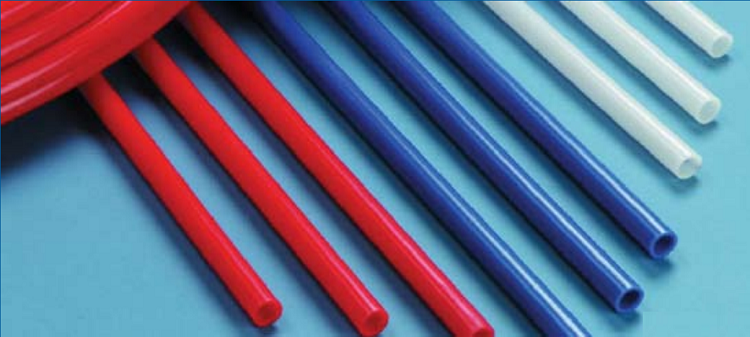While Copper, Steel and PVC remain the popular choices for residential and commercial pipes and tubes, the PEX pipe is showing tremendous growth in demand due to its cost and labor efficiency. Some applications of PEX pipes are radiant heating systems, snow melting, carrying municipal water and hot/cold water distribution. But what is a PEX? What are the advantages and applications of PEX pipes? We will learn more about PEX pipes in this guide. We will also see a PEX Pipe Size Chart, which lists out all the important dimensions of standard PEX pipes.
Outline
ToggleWhat is PEX Pipe?
Cross-Linked Polyethylene or PEX is a flexible, high-temperature plastic (polymer) tubing invented in Germany in the late 1960’s. Soon, it became the primary choice for residential water-supply plumbing across Europe. But this was not the case in the U.S.
Frequent comparisons of PEX and Polybutylene (PB) piping was one of the main reasons for Americans not accepting PEX piping in the initial days. If you are unfamiliar, Polybutylene Pipe was a main choice for plumbing in the U.S. between early 1970’s all the way up to late 1990’s.
But the material was not inert to Chlorine, which was a primary compound in municipal water, and the chemical structure of the polymer (polybutylene) got deteriorated as a result.
Many home owners, contractors and even officials were reluctant to use PEX pipes even though they are very different. But things started to change in the late 1980’s and early 1990’s, when the U.S. started using PEX pipes for radiant floor heating and later for domestic water plumbing.
As the PEX pipes were much cheaper than Copper and has several advantages over traditional piping, the use of PEX in America’s home water supply system skyrocketed in the last 15 years.
Characteristics of PEX Pipes
Cross-Linking is an important process in the manufacturing of PEX Pipes. It transforms the high-density Polyethylene into thermosetting polymer. Some of the Carbon – Hydrogen bonds in the polyethylene molecule are broken (using chemical or radiation process) during cross-linking.
To fill these gaps, adjacent polyethylene molecules bond to form a 3D network and the material can now be classified as thermoset polymer (which cannot be reformed or melted). Cross-Linking essentially increases the temperature and pressure capabilities of polyethylene.
While PEX pipes are available in Red, Blue and White colors, these colors have no significance regarding the capabilities of the pipes. For that, we need to take a look at three types of PEX Pipes: PEX-A, PEX-B and PEX-C.
Of the three, PEX-A has the highest quality and also the most flexible (obviously more expensive). We often use these pipes with expansion fittings. PEX-B Pipes are less expensive than both Copper and PEX-A and offers the best value for the users. We can use crimp-style connectors with PEX-B pipes.
Coming to PEX-C, we usually do not use these pipes for residential plumbing but sometimes use it for radiant heat and hot-water applications.
Advantages of PEX Piping
Here are some of the advantages of PEX Pipes over traditional pipes and tubes, especially in plumbing.
- As PEX pipes use mechanical connectors (expansion fittings or crimp-style connectors), there is no need for soldering, brazing or any chemical process. This significantly makes it easy for installation.
- The flexible nature of PEX pipes means that you can easily bend/maneuver them around obstacles or corners.
- PEX Pipes are generally resistant to corrosion and pitting. The chemical properties of these pipes prevent any mineral build-up and also makes them scaling resistant.
- They are available in a wide range of sizes. We will see more about dimensions of PEX Pipes in the later sections on PEX Pipe Size Chart.
- The overall cost of PEX pipes and their installation is significantly less than other piping systems. Also, the plumbing jobs are less labor intensive.
- PEX Pipes and their fittings are highly regulated through several standards and certifications.
Applications of PEX Pipes
We can use PEX Piping in a variety of home plumbing applications, for both hot and cold-water supply systems.
- Supplying municipal water underground
- Radiant floor heating systems in floors or slabs
- Use them in driveways, sidewalks etc. to melt snow and ice
- Turf conditioning in sports fields, golf courses etc.
- Residential fire suppression systems
PEX Pipe Size Chart
The ASTM F876 standard lists out all the standard dimensions and weights for PEX Piping. If you are constructing a new house or remodeling your existing house, then a PEX Pipe Size Chart will definitely come handy.
Following table shows the PEX Pipe Size Chart as per ASTM F 876 Standard.
| PEX Pipe Dimensions | ||||
| Nominal Diameter (inches) | Outer Diameter (inches) | Wall Thickness (inches) | Inner Diameter (inches) | Weight (lb/ft) |
| 3/8 | 0.5 | 0.075 | 0.35 | 0.05 |
| 1/2 | 0.625 | 0.075 | 0.475 | 0.06 |
| 3/4 | 0.875 | 0.102 | 0.671 | 0.1 |
| 1 | 1.125 | 0.13 | 0.865 | 0.16 |
| 1-1/4 | 1.375 | 0.16 | 1.055 | 0.25 |
| 1-1/2 | 1.625 | 0.19 | 1.245 | 0.35 |
| 2 | 2.125 | 0.248 | 1.629 | 0.6 |
In the above PEX Pipe Size Chart, the outer diameter and wall thickness are average values from the ASTM F 876 Standard.
Conclusion
PEX is a piping/tubing material made up of high-density polyethylene molecules that are permanently linked through cross-linking process. We can use PEX Pipes in a variety of residential plumbing applications for carrying both hot and cold water. A PEX Pipe Size Chart is a handy little table that lists out some of the important dimensions of standard PEX Pipes.


